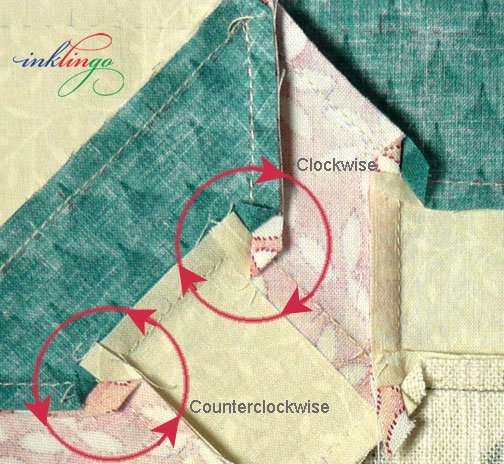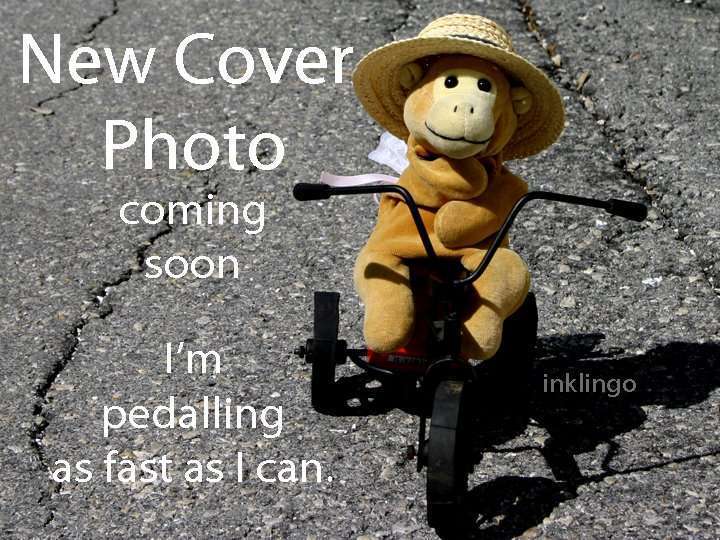
From the front, hand and machine pieced blocks look the same.
Inklingo Castle Wall is a hand piecer’s dream.
Portable. Precise. Fun. 3 sizes. Impressive! Lots of inset seams = relaxing continuous stitching.
Should we tell machine piecers, “No, no, no. This is not for you.” ? I think not!
We want to include ALL quilters in the fun and Inklingo makes it easier to machine piece a fortress of inset seams!

Castle Wall has Inset Seams
Hand piecers love inset seams.
Machine piecers avoid them. Not anymore, okay?
Inset seams are a hand piecer’s friend because you can turn a corner and keep on sewing. “Continuous stitching” is relaxing and fun and gives perfect results with fewer knots.
Inset seams often scare machine piecers away from beautiful designs like Castle Wall because it is difficult to judge where to start and stop sewing. Precision markings printed with Inklingo change all that.
There is no need to avoid inset seams when you print the shapes on fabric with Inklingo!
In my last message, there is a video showing inset seams by machine (hexagon example).
You can do it too!

What is the difference between hand and machine piecing Castle Wall?
Machine piecers usually sew from edge to edge and often sew through several layers of fabric where seams cross.
Hand piecers always sew from crosshair to crosshair (not edge to edge) and only ever sew through 2 layers of fabric. That gives more flexibility for sewing sequence and means all the pressing can be left to the end. (No more press as you go.)
Monkey is a hand piecing snob. He says sewing from crosshair to crosshair is “hand piecing by machine.” With crosshairs and precision corners printed accurately on every piece with Inklingo, machine piecers can sew from crosshair to crosshair too.

What is the same when you machine piece Castle Wall?
Whether you sew by hand or by machine:
- Sew crosshair to crosshair.
- Start and end each seam with a backstitch or locking stitch.
- Sew the seams in any order, but plan your route for “continuous stitching” and/or minimal pinning if you can.
- Use the same sewing sequence for hand piecing and machine piecing.
- Leave all the pressing to the end.

Bonus Hybrid Piecing with Machine Piecing Castle Wall
You can combine hand and machine sewing in the same block!
Last night I planned to sew as many seams as I could by machine and then finish the block by hand while watching TV with Russ.
My plan did not work out.
- I finished these two Castle Wall blocks (above) by machine before our show started!
(I sewed hexagons on the couch instead. Nice) - My idea for a different sewing sequence for machine piecing did not have any advantages compared to just using the normal sewing sequence for Castle Wall by hand.
(Things often seem harder/easier/better/worse in theory. You have to actually do it to know for sure.)
You can finish a machine pieced block by hand—or vice versa.
Problem: If you finish fast by machine, you might not have anything to pack in your portable kit.
Solution: Print some more!
Hybrid piecing is described in detail in The Inklingo Handbook. It is only possible because Inklingo prints accurate lines for every shape.
Observations on Machine Piecing Castle Wall
- Even without trimming the corners, Inklingo’s precision markings help align everything correctly (arrows above). If your machine has a walking foot, you may not need to pin at all but if you do, pin at the two crosshairs.
- Use the same sewing sequence for machine and hand piecing.
- Stitch from crosshair to crosshair and start and end each seam with a backstitch—by hand or by machine.

More Observations on Machine Piecing Castle Wall Quilt Blocks
- Press the same way whether you sew by hand OR by machine.
- Sew by machine when you can and sew by hand when you need it to be portable and/or quiet.
- Castle Wall 4.5 inch and Castle Wall 6 inch are harder to sew by machine than Castle Wall 9 inch. Stick to the larger sizes for machine piecing.
- Fussy cutting a great fabric makes each block even more fun no matter whether you print Inklingo templates to make Swiss cheese of the fabric OR you print the shapes on fabric with No Waste Fussy Cutting.
Video for Machine Piecing Crosshair to Crosshair
The video on YouTube and on the Main Hexagon Page on the website (under the Shop tab) shows all of my best tips for machine piecing from crosshair to crosshair.
I know you can do it too, but if you are hesitant you can try before you buy. Practice sewing from crosshair to crosshair by machine with the shape in the free Diamond Triangle Square shape collection. It’s probably easier than you think! (How to sew LeMoyne Star by Machine.)

More About Castle Wall
I have added “How to Machine Piece Castle Wall” to the list of lessons on the Main Castle Wall Page.
You can see my first machine pieced Castle Wall block here.
Even if you normally hand piece, I hope you will “Attack a Castle Wall” by machine and enjoy it as much as I did. It just might boost your confidence about precision machine piecing—and you can brag at your next guild meeting!
Please subscribe (top of right sidebar), so you don’t miss what is coming next! If you follow Inkingo on Facebook you will often get a sneak peek.
Thank you for visiting.
Linda & Monkey
Thank you for subscribing to the blog!






Me encantaría intentarlo pero antes necesitaría cambiar mi máquina de coser porque cuando aprieto el pedal parece un caballo desbocado. ¿Qué marca y modelo de máquina utiliza en el vídeo de los hexágonos? Por supuesto es muy importante su habilidad para usarla pero parece que puede coser despacio.
Un saludo Linda, me gusta mucho su blog, es muy ameno e innovador
Mercedes
Hola Mercedes,
He usado freetranslation.com para leer el mensaje.
Muchas gracias por tu hermoso comentario. Mi única máquina de coser es un Pfaff 7550. Lo compré hace unos 20 años. Hoy en día no creo que sea muy caro comprar una máquina para obtener las características más me gusta: de pie a pie, aguja arriba/abajo, y el control de velocidad. Me encanta este equipo, pero ha sido un largo tiempo desde que me he comprado uno nuevo que no puedo hacer una buena recomendación sobre las nuevas máquinas disponibles ahora.
Espero que puedan encontrar algo de lo que usted disfruta con tanto como yo lo disfrute con la mía.
Abrazos,
Linda & Monkey en Canada
I used freetranslation.com to read your message:
I would love to try again butbeforewill need to change my machine sewing predicament because when the pedal looks like a runaway horse. What make and model of machine used in the greenwaydeo of the Ã’Â? Of course it is very important its ability to use it but it seems that you can sew slowly.
A greetings Linda, i really like your blog, is very enjoyable and innovative
Thank you very much for your lovely comment. My only sewing machine is a Pfaff 7550. I bought it about 20 years ago. Nowadays I don’t think you need to buy a very expensive machine to get the features I enjoy the most: built-in walking foot, needle up/down option, and speed control. I still love this machine but it has been such a long time since I bought a new one that I cannot make a good recommendation about the new machines available now.
I hope you can find something you enjoy using as much as I enjoy using mine.
I like Monkey’s view of “hand piecing by machine” – what a smart monkey!
These blocks are so perfect, it’s hard to believe the results are by machine! But I do believe it. I’ve seen your videos showing how.
Wow!!!
Dear Linda,
Again we are so Lucky to have you! Another great post for the quilters who like to use the sewing machine instead
of hand sewing.
Thank you so much.
Louise.